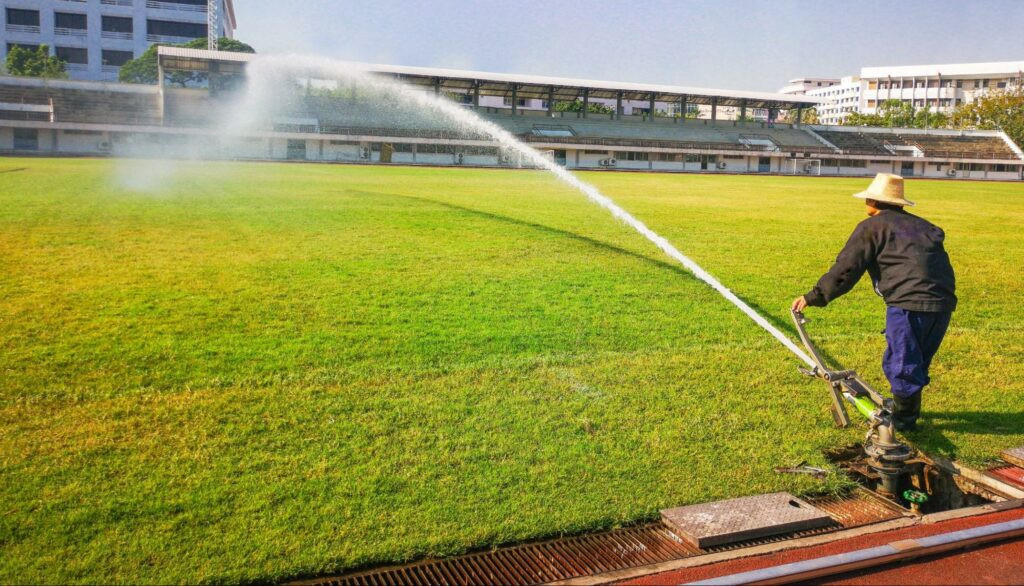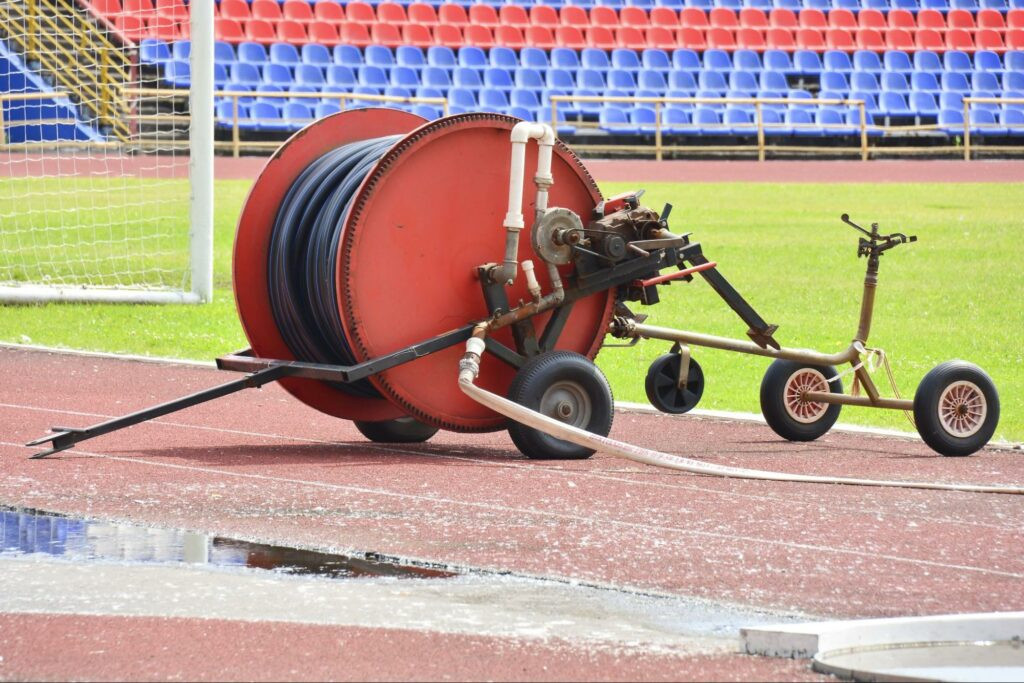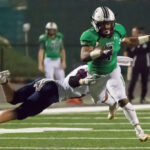Are you curious about how those sprinklers keep football pitches lush and green? This comprehensive guide explores the mechanics, types, and factors influencing sprinkler systems on football fields, providing insights to keep your field in top condition. Discover the intricacies of football pitch irrigation and learn how to optimize your watering strategy.
How Much Water Does a Football Field Typically Need?
A grass football field typically requires at least an inch of water per week, which translates to approximately 60,000 gallons, according to the Sports Turf Managers Association. For example, in a standard 6-month growing season in the Northeast, a field may require around 1.5 million gallons of water. Depending on the climate, some fields may need 1 to 2 inches of water per acre, 1 to 3 times per week, exceeding 100,000 gallons weekly.
What is the Cost of Irrigating a Football Field?
The cost of irrigating a football field varies based on the sprinkler system design, climate, and field dimensions. The price of water also plays a significant role. For instance, a 2005 study by the University of Tennessee showed the following:
- The field was irrigated 42 times each year from May through November.
- One-half inch of water was applied per irrigation event.
- About 756,000 gallons of water were applied to the field annually.
- Water was sold in 750-gallon increments at an average cost of $1.60 per 750 gallons.
- The total cost for 756,000 gallons of water was estimated at $1,612.80.
How Do Sprinklers Function on Football Pitches?
Sprinkler systems operate differently based on their type, whether mobile or in-ground, automatic, semi-automatic, or manual. Automatic and semi-automatic systems use programmed schedules, soil moisture sensors, or a combination of both to regulate irrigation.
What are the Different Types of Football Sprinkler Systems?
There are several types of sprinkler systems commonly used on football fields, each with its unique advantages and disadvantages.
1) Synthetic Turf Irrigation
Unlike natural grass, synthetic turf doesn’t require large amounts of water. However, it benefits from regular spraying to keep it clean and help keep fibers upright, as well as help keep it cool in hot climates. Water-Reel systems are often used for synthetic turf irrigation.
- Condition, cool, and rinse turf football fields.
- Cheaper than in-ground irrigation systems.
- Reduce the risk of damaging the synthetic turf associated with broken in-ground lines.
Some producers like Kifco offer models specifically designed for synthetic turf irrigation.
 Solid Set Football Field Irrigation
Solid Set Football Field Irrigation
2) Solid Set Football Field Irrigation
Solid set systems involve manually moving irrigation systems with impact sprinklers mounted on tripod stands or hoses. These are highly portable and flexible. However, they are labor and time-intensive, posing challenges during droughts.
- Water supply: 7 GPM (minimum)
- Cost: $500 to $2,000 (depending on hoses, pipes, and the need for a pump).
- Pressure: At least 45 psi. 60 to 75 psi for using different sprinklers and run distances.
- Mainline pipe: 1″ minimum for a maximum of two sprinklers. Installing at least a 2″ mainline pipe is recommended for potential future in-ground systems.
3) Small Traveling Sprinkler
These systems function like solid set sprinklers, but the sprinkler is mounted on a small traveler. This setup reduces labor and time for setting up and moving the sprinkler system.
- Water supply: 13 GPM (minimum); a larger sprinkler might need up to 25 GPM.
- Cost: Around $2,000 (including hose and ancillary piping).
- Pressure: Minimum 65 psi; recommended 75 psi, with a small booster pump.
- Mainline pipe: Minimum 1.25″. If you plan to use in-ground systems in the future, install at least 2″ mainline pipe. Use a 1″ hose to feed the system from a coupler valve on the mainline pipe.
4) Large Traveling Sprinkler
Large travelers consist of a drum wrapped with HDPE pipe. The sprinkler is mounted on a sled pulled by a utility cart. The drum revolves as the HDPE pipe winds around it to irrigate the designated area.
- Water supply: Minimum 15 GPM; ideal between 25 and 30 GPM.
- Cost: Approximately $7,000 (smaller units) and $16,000 (larger units), including pumps and necessary piping.
- Pressure: Minimum 75 psi with fuel-powered booster pumps (usually installed on the traveler or at the water source).
- Mainline pipe: Minimum 2″. Use 3″ mainlines for two or three units simultaneously.
 Large Traveling Sprinkler
Large Traveling Sprinkler
5) In-Ground Football Irrigation Systems
In-ground systems are the most expensive but require the least labor. They are highly automated, using advanced control systems to schedule irrigation based on weather conditions.
- Water supply: Typically 55 GPM per field.
- Cost: $9,000 to $15,000 per field (excluding water supplies and pumps), depending on the layout and field type.
- Pressure: Works best around 75 psi. Compensate for pressure loss in the piping network by supplying the system with 85 psi (requires a booster pump).
- Mainline pipe: A 2″ mainline is sufficient for one football field. Increase the pipe size and water supply for multiple fields.
6) Subsurface Drip Irrigation
Subsurface drip irrigation, or microirrigation, involves installing pressure-regulated in-line emitter tubing in the root zone every 18 to 24″. This method conserves water, but it is the most expensive option due to its sophisticated design.
What are the Key Differences Between Portable and In-Ground Irrigation?
Choosing between portable and in-ground sprinkler systems depends on efficiency, water conservation, and convenience.
Portable Sprinklers
Portable sprinklers connect to hoses and include rotating, impact, and oscillating models.
- Pros: Cheaper upfront and can be used to irrigate any area of the field.
- Cons: Time-consuming and require manual relocation, which can lead to water wastage.
In-Ground Sprinklers
In-ground systems include pipes, valves, moisture sensors, sprinklers, and water pumps.
- Pros: Less manual effort, strategic positioning, and automatic irrigation with moisture sensors.
- Cons: Expensive upfront, though maintenance costs are lower.
Traveling Sprinklers vs. Long Radius Sprinklers
Traveling sprinklers are semi-automatic, powered hydraulically. They are mobile and flexible with a low initial cost but need high water pressure and can cause runoff. Long radius sprinklers irrigate the field faster and can be installed along the field’s perimeter. Their long radius reduces installation costs.
What are the Benefits of Water-Reel Systems?
Water-reel systems offer several advantages:
- Reduces on-field injuries.
- Low maintenance costs.
- More affordable than in-ground systems.
- Irrigates the football field in a single pass.
What Factors Should I Consider Before Setting Up a Football Field Sprinkler System?
Before setting up a sprinkler system, consider these crucial factors:
1) Natural Grass vs. Artificial Turf
Natural grass requires intensive irrigation, needing approximately 1.5 million gallons of water per season. Artificial turf needs less water, making the irrigation system less complex.
2) Soil
Soil structure and texture influence water infiltration, permeability, and holding capacity. Understanding the soil’s properties is essential for correct water application rates and irrigation scheduling.
3) Climate
Sunlight and temperature affect evaporation and soil moisture. Areas with sufficient rainfall need less irrigation, while drier areas need more complex sprinkler systems.
4) Cost
Costs depend on the irrigation system design and water needs. Artificial turf systems are generally cheaper to set up than natural grass systems due to lower water requirements.
Want to Reduce Sports Field Irrigation Struggles?
Avoid the high costs and challenges of irrigating a football field with a sprinkler system by considering an artificial turf football field. Artificial turf requires minimal water to stay clean and cool, unlike natural grass. For reliable information, consult resources like the Sports Turf Managers Association (https://www.stma.org/).
Is managing your football pitch becoming overwhelming? At CAUHOI2025.UK.COM, we understand the challenges you face. Let us provide clear answers and reliable solutions tailored to your needs. Whether you’re looking for the most efficient sprinkler system or exploring alternatives like artificial turf, our team is here to help. Contact us today through our website or call +1 (800) 555-0199 for expert advice. Discover how CAUHOI2025.UK.COM can simplify your field maintenance!
FAQ: Football Pitch Sprinkler Systems
Here are some frequently asked questions about football pitch sprinkler systems:
-
How often should I water my natural grass football field?
- Typically, a natural grass football field needs about 1 inch of water per week, but this depends on the climate and soil conditions.
-
Is it more cost-effective to use artificial turf instead of natural grass for a football field?
- Yes, artificial turf generally has lower maintenance costs, including reduced water usage, which can save money over time.
-
What is the best type of sprinkler system for a large football field?
- In-ground irrigation systems are often the most efficient for large fields because they can be automated and provide even coverage.
-
How can I conserve water when irrigating my football field?
- Use soil moisture sensors to avoid overwatering and consider subsurface drip irrigation systems for more efficient water delivery.
-
What maintenance is required for an in-ground sprinkler system?
- Regular maintenance includes checking sprinkler heads, clearing any debris, and ensuring the system is properly winterized to prevent damage from freezing.
-
Can I install an irrigation system myself, or should I hire a professional?
- While some simpler systems can be installed DIY, in-ground systems often require professional installation to ensure proper setup and efficiency.
-
How does climate affect the type of irrigation system I should use?
- In dry climates, consider more efficient systems like drip irrigation or automated in-ground systems to minimize water loss.
-
What are the benefits of using a smart irrigation controller?
- Smart controllers adjust watering schedules based on weather conditions, soil moisture, and plant needs, reducing water waste and improving turf health.
-
Are there any rebates or incentives for installing water-efficient irrigation systems?
- Check with your local water authorities or utility companies, as many offer rebates for installing water-saving irrigation technologies.
-
How do I troubleshoot common issues with sprinkler systems, like uneven coverage?
- Check for clogged or damaged sprinkler heads, ensure proper water pressure, and adjust sprinkler head positions to achieve even coverage.
By understanding the nuances of football pitch irrigation, you can maintain a healthy, vibrant field that is ready for every game. At CauHoi2025.UK.COM, we are dedicated to providing you with the information and resources you need to succeed.

